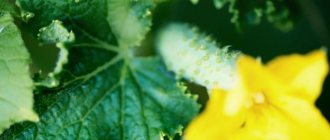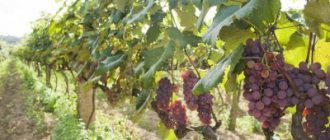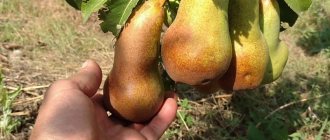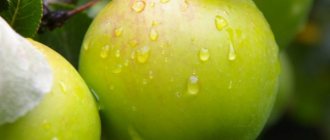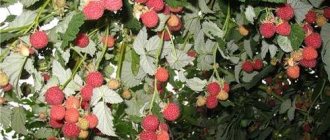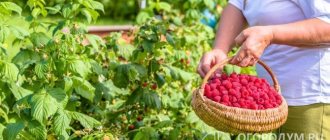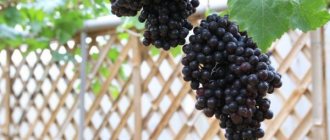Gooseberry Beryl is a winter-hardy variety bred for unfavorable northern conditions. It is valued for its endurance, unpretentiousness and excellent dessert taste of juicy, light green berries. Let's find out how to plant and grow this frost-resistant gooseberry.
gooseberry variety "Beryl"
It is very convenient to harvest from “Beryl” gooseberry bushes, as it has a minimal number of needles
gooseberry "Beryl" has a high yield, producing 3-10 kg of berries per season
Brief description of gooseberries
Brief botanical description of Beryl gooseberry:
- Bush. Medium height and spreading, with a dense but neat crown. There are few thorns, they are directed downwards, usually located at the bottom of the shoot. There are no thorns on zero shoots.
- Leaves. Large, green, hairless, soft, five-lobed. The surface is slightly wrinkled.
- Flowers. Large, glass-shaped. Brightly colored, inflorescences are two-flowered.
- Fruit. Large, yellow-green or light green, weigh 4-9 g. Sometimes the berries have a reddish blush. This gooseberry often has berries that grow twice as large as cherries. The skin is thin, smooth, no pubescence. The pulp is juicy, there are few seeds in it. The stalks are long and thin.
Description of the bush and berries
Gooseberries of the Beryl variety are characterized by medium height and medium spreading, a dense crown and a small number of thorns, which are located singly in the lower part of the shoot. Usually they “look” down, less often they move away from the branches at an angle of 90 degrees.
The leaves of the Beryl variety are large, five-lobed, soft green in color, the edges of which are framed by elongated teeth. The leaves are not pubescent, with a shiny leaf blade.
Gooseberry shoots are curved and hang down. The flowers of this variety are goblet-shaped and form a two-color inflorescence. The developing fruits are light green in color, with a smooth surface and thin, transparent skin.
Dessert gooseberries have a sweet and sour taste and have a high tasting rating. They are large in size - up to 9 g (larger than cherries). This is the maximum size, and the average size is 4 g. The berries are sweet due to the content of monosaccharides in their composition, and ascorbic acid and a number of other organic acids give them sourness. As gooseberries ripen, they become sweeter and acquire an amber-green hue.
General characteristics of the gooseberry variety Beryl are presented in the video:
Advantages and disadvantages
The Beryl variety has many positive qualities, but there are also minor disadvantages, which are shown in the table.
| pros | Minuses |
| Frost resistance: withstands temperatures down to -38°C | poor resistance to septoria |
| resistance to powdery mildew | |
| unique, special taste qualities of berries, their large size | |
| high yield | |
| self-fertile (no need for pollinators) | |
| a small number of thorns | |
| good transportability |
Advantages and disadvantages of the variety
Benefits of Gooseberry Beryl:
- high self-fertility - natural pollination guarantees 50% of the harvest;
- ability to tolerate short-term droughts without loss of yield;
- good transportability during the period of technical ripeness;
- the versatility of the fruit - they are eaten fresh, made into preparations, desserts, liqueurs;
- high frost resistance - in many regions the bushes do not even have to be covered for the winter;
- large and tasty fruits;
- high yield - the variety is profitable to grow for commercial purposes.
Flaws:
- may be affected by septoria;
- affected by sawflies;
- drop in yield due to violation of agricultural practices;
- poor keeping quality of ripe berries.
Brief description (pros, cons)
Advantages of the variety
- Winter hardiness. Without shelter, it can withstand temperatures down to -35˚C.
- High yield (up to 7-9 kg of berries per bush).
- Good transportability. Ripe berries can withstand long-distance transportation without deformation.
- High keeping quality.
- Resistance to fungal infections, powdery mildew.
- Large fruits, excellent taste.
- Self-fertility. No pollinator planting required.
- A small number of thorns.
- Versatility. The berries are used fresh, as well as for making jam, wine, jelly, and compotes.
- Stable fruiting.
- Early maturation. The first berries are harvested in mid-July.
- Powdery mildew resistance
Among the disadvantages of the variety, the possibility of infection by septoria is noted.
Septoria blight is a fungal disease that appears as gray and rusty spots on the leaves.
Varietal features
The variety was bred specifically for the harshest growing conditions. Let's learn more about the main agrotechnical characteristics of Beryl.
Productivity
The variety is considered high-yielding. 8-10 kg are collected from one bush. This gooseberry is suitable for any type of cultivation - amateur and industrial. An average of 10 tons of berries are harvested from 1 hectare, the maximum is 30 tons.
Beryl gooseberries are sweet and sour, juicy. The taste is dessert. Tasters rate the taste of the berries at 5 points, in the State Register - 4.3 points. 100 g of fresh gooseberries contains 8-9.9% sugar, acids - 0.5-2.2%, vitamin C - 17 mg.
See below for a video review of gooseberries of the Beryl variety:
Ripening dates and fruiting characteristics
The variety belongs to the mid-late category. The berries ripen around mid-July. The bush begins to actively bear fruit in the 5th year after planting.
Drought resistance and winter hardiness
The variety is frost-resistant, can withstand frosts down to minus 38°C, so it can grow without shelter in regions with harsh winters. The variety does not like excessive dampness; it is also highly resistant to drought.
Resistance to diseases and pests
The variety has average immunity to traditional diseases of gooseberries and other berry crops. Beryl is moderately resistant to powdery mildew and fruit rot, but is susceptible to septoria. Due to fungal infections, the bushes are stunted in growth and, if left untreated, die.
The most dangerous sawflies for Beryl are the palelegged and yellow gooseberry. Their larvae eat the leaves, destroying all green parts of the bush.
Transportation Features
To extend the shelf life of the berries, they are picked slightly unripe - at the stage of technical maturity. Then the fruits remain fresh for 3 days and can easily withstand transportation.
Berries collected at full ripeness are transported much worse; ripe Beryl gooseberries are not transported over long distances.
Growing conditions
Requirements for growing conditions:
- There are no special requirements for soils. Loamy, sandy and sandy loam soils with an average pH value are suitable.
- Wetlands and highly acidic soils are not suitable.
- Choose a sunny site - the taste of the berries depends on the amount of sun.
- There should be no drafts or blowing winds on the site.
- The occurrence of groundwater is moderate, not less than 1.5 m.
Growing conditions
Beryl does not create special growing conditions for gooseberries. It can be planted on clay and loamy, sandy and sandy loam soil. It will not grow on acidic, swampy, cold soils. On loams with a high humus content, this variety produces the best fruit.
An open, well-lit place is suitable for planting. When thickening a gooseberry bush, thinning is important so that each shoot has access to sunlight and air.
Important! The variety has become popular due to its unpretentiousness, frost resistance and stable fruiting.
He does not need special care techniques and only in case of illness requires a more attentive attitude towards himself.
Selection of seedlings
For planting, seedlings over 2 years old are taken. They must have a well-formed root system and woody trunks - such seedlings take root better. The seedling should have 2-3 shoots 20 cm long.
What else to pay attention to when choosing gooseberry seedlings:
- take planting material with a closed root system - in containers, pots, film bags;
- shoots must be strong and trimmed;
- the buds must be healthy, the leaves must be free of spots, the bark must be fresh.
Features of reproduction
It is best to propagate Beryl gooseberries by cuttings or dividing the bush. Bushes can be divided at the age of 3-4 years. To do this, the bush is carefully dug up, separated with a shovel and planted immediately in a permanent place. When propagating by cuttings, preference is given to two-year-old seedlings. They take root well, but require storage space. Many gardeners propagate gooseberries by layering.
Detailed landing instructions
The entire subsequent life of the gooseberry bush depends on the planting conditions - its immunity, productivity, growth and development. We will learn how to properly prepare for landing and how to carry it out.
Preparing the landing site
Before planting gooseberries, prepare the soil and planting hole:
- Determine the acidity of the soil. If the value is high, deoxidize the soil with dolomite flour. Apply it at the rate of 300 g per plant.
- Dig up the place where the seedling will be planted, removing all weeds and their roots. Add phosphates and ash when digging, and add fertilizers, compost, and sand to heavy soils.
- Dig a hole 35-40 cm deep and wide.
- Pour well-mixed soil mixture into the bottom. It is prepared from a fertile layer of soil, 2 buckets of compost, as well as mineral fertilizers - for example, 30 g of superphosphate and 20 g of potassium phosphate. If the soils are heavy, river sand, humus and peat are added to the soil mixture.
Disembarkation scheme
Gooseberries are often planted between rows of trees growing in elevated and sunny areas. Here the bushes will be in slight partial shade - this is acceptable for gooseberries. In addition, trees will protect the bushes from drafts.
To ensure that the gooseberries have enough space to grow and form a bush, gaps of at least 1.5 m are left between the pits. The depth and width of the pit takes into account the size of the root system.
Step-by-step recommendations
The best time to plant gooseberries is early spring or autumn (late September-early October). In the fall, gooseberries are planted a month and a half before frost, so that the root system has time to form. The temperature, including at night, should not fall below 5°C.
Before planting, you must have seedlings and a hole prepared taking into account the characteristics of the soil and the time of planting. If planting is done in the spring, organic fertilizers can be added to the hole. Autumn planting is carried out without organic fertilizers - larvae, beetles and other pests that can harm the roots of the plant often overwinter in them.
- Before planting, soak the seedling for half an hour in the HB-101 solution - only 2 drops of the drug are needed per 1 liter of water.
- Place the seedling vertically in the planting hole. When placing the seedling, keep in mind that the gooseberry core should be buried 6-8 cm into the soil.
- Distribute the roots evenly over the loose soil mixture.
- Cover the roots with fertile soil, shaking the seedling from time to time and tamping the layers with your hands so that there are no voids between the roots.
- After planting the seedling, prune it, leaving 4-5 growth buds on each branch.
- Water the seedling with water - one bucket is enough.
- When the moisture is absorbed, sprinkle the tree trunk circle with sawdust, hay or fallen leaves.
Reproduction methods
There are several different ways to grow gooseberries:
- layering (vertical, horizontal or arcuate);
- cuttings;
- perennial shoots;
- dividing the mother bush;
- through vaccination;
- seeds.
The most popular method among gardeners is propagation by horizontal layering .
Read more about gooseberry propagation.
For this method you need:
- In March, before the buds open, select several young strong shoots from each side of the bush.
- Dig furrows 10 centimeters deep.
- Place the branches in furrows so that they lie completely on the ground, including the part that extends from the root.
- Cut off the top by 3-4 cm and lower it into the ground.
- Attach the shoot to the ground with pins.
- Do not cover with soil immediately. When shoots about 5 cm tall appear on the shoots, they need to be sprinkled with earth.
- When they reach 15 cm in height, they should be completely covered, right up to the top, with damp soil, preferably after rain.
- In the summer, you periodically need to rake up the soil for layering and add saltpeter, potassium salt and superphosphate.
- If the soil is very dry, water it.
- With rapid growth, the shoots should be pinched.
- By autumn, the root system will be sufficiently developed, so that the cuttings can be separated from the bush and transplanted to a prepared place.
This method is optimal for 3-4 year old plants.
Important! The berries of the first harvest should be picked while still small, this will improve productivity in the future.
Arc-shaped layering is done in the same way, but there are a few nuances:
- The layering is fixed only in the middle.
- They immediately sprinkle it with earth, leave the pinched top above the ground, bend it in an arc and tie it to a peg.
- Cover with humus on top.
- In summer, water and fertilize at least 2 times.
- Separate in the fall and replant.
When the bushes are old, the vertical layering .
To do this, do the following in early spring:
- All old branches are removed from the bush.
- Young shoots are trimmed, leaving only one third of the length.
- After this procedure, the bush will begin to rapidly produce new shoots.
- When the new growth reaches 15 cm in length, the bush is carefully covered with fertile soil. It is necessary to hill up all the voids between the young growth. The soil should cover half the length of the branches.
- In summer, soil is added as the shoots grow.
- In the second half of July, the tops of the branches need to be pinched.
- In summer you need good watering and fertilizing at least 2 times.
- In the fall, you can free the bush from the ground, separate the shoots and replant.
For propagating gooseberries with green cuttings, an important factor is time - the first half of July, not earlier and not later.
To do this you need:
- Take cuttings early in the morning. For better rooting, you need to cut off the tops of the branches, about 20 cm long, with at least 8 nodes.
- Before planting, soak the bottom of the seedling in a solution with a preparation to activate growth.
- Prepare the substrate - to do this, combine peat and sand in equal parts.
- Plant the seedlings in the substrate, deepen them by 2-3 cm.
- Cover with film.
- In a greenhouse, the soil temperature should be at least +20°C, air temperature - +25...+27°C, humidity - 90%. This microclimate must be maintained for the first 10–15 days, then the greenhouse must be periodically ventilated.
- Seedlings are planted in a permanent place in the spring.
Another effective and common method is propagation by combined cuttings . These are green shoots with part of last year's lignified growth, about 4-5 cm long. Such cuttings are simply cut from the mother bush. Propagation by this method can be carried out during the growing season, starting in mid-May.
Everything is very simple:
- The cut cuttings are immediately planted in loose, moist soil. Deepen the seedling by 3-4 cm.
- After planting, a hole is made, filled well with water, and a layer of mulch made from humus, straw or sawdust is applied.
These are the simplest and most effective methods for breeding gooseberries of the Beryl variety.
Beryl Care Basics
There is nothing complicated or unusual in caring for Beryl gooseberries. For successful growth, development and fruiting of this variety, standard measures are sufficient - watering, fertilizing, spraying, pruning.
Read on for more information on how to care for gooseberries in the fall.
When and how to prune?
Gooseberries are pruned early in the spring, before the buds open, or late in the fall. In adult bushes, it is recommended to cut off 2/3 of the old branches at soil level - this will rejuvenate the plant and initiate the growth of new shoots.
Beryl gooseberry bushes require regular pruning; they actively form shoots that thicken the plant. Lack of nutrition caused by the growth of the bush prevents the development of young shoots, a drop in yield and the shrinking of berries.
Principles of pruning:
- In the spring, immediately after the snow melts, they begin pruning.
- They carry out sanitary pruning - remove all old, diseased and damaged branches.
- One-year-old shoots are shortened.
- Thin out the root branches - leave 4-5 pieces, the healthiest and strongest.
- Form the crown of the bush. The main branches are shortened by 50%. Leave no more than 20 branches of different ages.
- All weak and thickening branches of mature bushes are cut out.
- In summer, the ends of the fruiting branches are pinched so that the berries are larger.
How many times and in what volume should I water?
If the summer is hot and dry, artificial watering will be needed. It is especially important to water gooseberries during important periods of the growing season - during flowering, fruit set, and ripening of berries. Watering is stopped 2-3 weeks before harvesting.
The approximate frequency of watering is once a week. Water is poured at the root, trying not to get on the shoots and leaves. 1 bucket of water is poured into the tree trunk circle. If the summer is rainy, there is no need to water the bushes additionally - excess moisture causes the berries to lose their taste and other quality indicators.
The gooseberry tree trunks are regularly loosened, removing weeds along the way. Loosening improves air exchange in the soil, and to retard the growth of weeds and evaporation of moisture, the soil is mulched. During the season, 4-5 loosening is carried out.
Feeding scheme
Fertilizer application is a prerequisite for obtaining a harvest from Beryl. The sequence of fertilizing is in Table 1.
Table 1
| Application period | Feeding composition |
| Early spring | Humus is scattered under the bush. |
| End of spring | Mineral fertilizers are applied, including nitrogen fertilizers - they are needed for the growth of shoots and green mass. For 1 sq. m add 20 g of ammonium nitrate or organic matter - bird droppings, manure. |
| End of June. Flowering in its final stage. | Phosphorus-potassium fertilizers are applied - potassium phosphate or superphosphate, 20 g per 1 sq. m. m. This is necessary for the successful formation of ovaries. |
To ensure a good harvest next year, do not leave berries on the branches - all fruits must be collected.
Application of support
Gooseberry supports are small fences made of wooden blocks, metal or plastic pipes.
Why are supports needed:
- maintaining compactness of the bush;
- preventing branches from lodging;
- branches do not break in wind and snowfall;
- the berries do not get dirty on the ground;
- It makes caring for the bush easier - it’s easier to water, loosen, and mulch.
Reproduction
The Beryl variety is propagated in any way traditional for shrubs. Each gardener chooses the method that is best suited for a particular situation.
Methods for propagating Beryl gooseberries:
- Dividing the bush. Apply in the fall. The bush is easily divided into parts without getting stressed.
- By cuttings. This method is used in summer. Cuttings with five buds are cut from new growth. The resulting material is planted in the ground at an angle of 45 degrees.
- By layering. A simple and convenient way of propagation. The cuttings are lowered into grooves dug near the trunk. The cuttings are fixed so that they take root in the ground.
- Vaccination. The scion is grafted onto the rootstock - an old gooseberry bush. Old branches are cut off, and a split is made in the stump, where the scion is inserted.
Preparing for winter
Bushes are prepared for winter when the average daily temperature drops below 0°C. Procedure for preparing for winter:
- Water the bush generously – 5-6 buckets of water. This is moisture-recharging irrigation for the winter.
- Bend the branches of the bush to the soil and secure. The branches should not lie completely on the ground. There should be 8-10 cm between them and the ground.
- Mulch the soil near the bush with a layer of 7-8 cm. If the temperature drops below minus 15°C, increase the thickness of the layer to 20 cm. If the winter is snowy, cover the gooseberries with snow, pouring it on the bushes.
To prevent premature development of buds and their freezing due to return frosts, all shelters are removed early in the spring.
Reviews
I have been growing the Beryl variety for several years. I read a lot of reviews and descriptions of the variety, but nowhere did I find information about the need for arranging supports. I will say that at first I also did not pay attention to this moment, but then, when the branches were on the ground, I realized that it was impossible to do without support. Moreover, my supports are different; I use arcs on several bushes; I made a support from planks for one bush. Any option works, the main thing is to raise the branches from the ground so that the berries are not dirty from the ground and do not rot. In addition, the supports allow the stems to be better oriented towards the sun, the crop ripens faster. My wooden support consists of four pegs onto which I place horizontal strips at a height of 40-50 cm from the ground. By winter, I either remove the supports or try to bend the branches under the slats so that they become closer to the ground and do not stick out above the snow. Maybe due to the supports, I have never encountered septoria, which develops primarily from excess moisture.
I live in Tyumen. For us, yield and fruit size are still secondary criteria. The main thing is that the plant does not freeze. You can also plant peaches for a few months, but there’s no point in such gardening. I have been growing beryl for seven years, and so far there have been no problems with wintering, so I can confidently recommend the variety to other gardeners in the Urals and Siberia.
Having an extensive list of positive characteristics, Beryl gooseberry is confidently becoming one of the popular varieties in regions with a cold winter season. Gardeners are attracted by its simple care, as well as the opportunity to diversify the diet with large and pleasant-tasting berries already in June.
Pests, signs and control
Beryl is not particularly vulnerable to pests. It is quite resistant to ticks and other gnawing and sucking insects. The greatest danger to Beryl is from moths, sawflies and aphids.
table 2
| Pests | Damage caused | How to fight? |
| Aphid | The leaves curl, dry out and fall off. The shoots are deformed and stunted in growth. | At the end of spring, the bushes are sprayed with Karbofos or Vofatox. |
| Ognevka | Butterflies lay eggs in the buds. The larvae, upon hatching, weave cocoons around the ovaries. The fruits grow poorly and fall off. | When the bush fades, it is sprayed with Actellik or Karbofos. |
| Sawfly | Caterpillars gnaw through leaves, ovaries and shoots. | In the spring, in May, they are sprayed with insecticides or folk remedies - pine extract or soap solution. |
Pest and disease control
Most often, gooseberries of the Beryl variety are affected by septoria. The disease is caused by a fungus that develops on the leaves in the form of spots. Then they merge and the leaf falls off. Dark spots form on the spots - these are fungal spores that fall on the berries and infect them. The disease actively develops and “attacks” the variety in wet weather; thickened gooseberry plantings also contribute to its development. Septoria blight greatly affects the subsequent harvest.
Control measures:
- cleaning and burning fallen gooseberry leaves;
- digging up the soil;
- thinning thickened branches;
- application of fertilizers, which increases resistance to disease;
- treatment with antifungal drugs.
Of the pests, the Beryl gooseberry bush is most often visited by aphids, moths, and sawflies. If detected in a timely manner, it is enough to treat the bushes with ash-soap solutions or Bordeaux mixture.
Diseases, symptoms and treatment
The better the growing conditions, the more chances the gooseberry has to avoid diseases. Table 3 shows diseases that pose a danger to the Beryl variety.
Table 3
| Diseases | Symptoms | How to fight? |
| Septoria (white spot) | The fungus affects the entire bush. Small gray spots with a brown border appear on the leaves. Leaves curl and fall off. The bush may die. | They use fungicides, Bordeaux mixture, and it is also recommended to spray the bushes with potassium permanganate, boron, and zinc. The bushes are treated twice per season - in autumn and spring. |
| Powdery mildew | This disease affects bushes with high humidity and lack of preventive spraying. This fungal disease is accompanied by the appearance of a whitish, powdery coating on the leaves and at the ends of branches. | Until the buds open, spray with copper sulfate (10 liters - 120 g) or colloidal sulfur (150 g). |
| Anthracosis | Brown spots appear on the leaves. Leaves and shoots turn yellow and fall off. | Treatable. Spray with Bordeaux mixture (per 10 l - 100 ml). The bushes are treated 4 times per season with an interval of 20 days. |
Landing
For a good and constant harvest, the bush must be planted correctly. In order to correctly select the location, seedlings and optimal planting time, it is necessary to study some features of the variety’s agricultural technology.
Deadlines
Gooseberry bushes can be planted in autumn and spring; time is not very important. But experienced gardeners still recommend planting in mid-September - this gives the plant more time to adapt and take root.
Choosing a suitable location
This species is not picky about the soil , the main thing is that the place is not swampy, but the soil is of medium acidity. It is desirable that the plant has access to sunlight and is not exposed to much wind.
Selection and preparation of planting material
Seedlings should be purchased from trusted sellers. Before purchasing, you need to make a visual assessment of the bark - it must be free of damage and visible diseases. The seedling should have a good woody and moist main root approximately 30 cm long.
It is worth choosing a 2-year-old plant with 3-4 powerful young shoots about 25 cm long. The buds should be swollen, but not blooming; leaves are allowed only on the upper part of the shoots.
Did you know? Before the revolution, gooseberry jam was called “royal”, or emerald, for its characteristic, very attractive appearance and taste.
Planting scheme
The planting scheme is quite simple:
- Dig holes 45–50 cm wide and deep.
- The distance between bushes should be at least a meter.
- Pour a mixture of humus, sand and mineral additives into each cavity.
- Place the seedling vertically and tamp it down well.
- The root collar should be underground.
- After planting, make a hole around the bush and water it generously.
- At the end, trim the shoots by 10–15 cm; mulch the ground under the bush with humus, straw or sawdust.
Basics of prevention
The greatest danger to beryl gooseberries is septoria. In order to prevent septoria and other diseases, the following preventive measures are taken:
- In autumn and spring, they dig up the soil in the tree trunk circle.
- Fallen leaves are raked and burned to destroy pests.
- Fertilizers are applied in a timely manner.
- Remove weeds and loosen the soil - this destroys the mycelium of powdery mildew.
- Cut off all old and diseased branches.
- Sprayed for preventive purposes with antifungal drugs, Bordeaux mixture, solutions of wood ash and liquid soap.
Growing rules
Caring for Beryl gooseberries is made easier due to its drought resistance and undemanding nature for loosening the soil.
- Watering gooseberries is carried out only as needed in dry years.
- Loosen the soil around the bushes 4-5 times per season, combining with fertilizing.
- In the spring, it is recommended to add compost directly under the gooseberry bush. Before the end of flowering, another fertilizing is carried out using organic fertilizers. Next, mineral or complex fertilizers are used, which include phosphorus, potassium and magnesium.
- In the spring, sanitary pruning is performed, removing all damaged and old shoots.
Reviews about the variety "Beryl"
★★★★★
Olga Sh., Nadym. An excellent variety - the berries are sweet, not fluffy, and they are easy to pick, since there are almost no thorns.
Of course, you have to take care of the bushes if you want to get a decent harvest, but this won’t surprise us northerners - here every crop has to be tended to. Beryl can withstand severe frosts, but I still cover it for the winter. ★★★★★
Alexey K., Novosibirsk region. This variety cannot be called unpretentious.
To get a harvest you have to run around with a sprayer. This is perhaps the main problem of Beryl - fungal diseases. If you don’t take care of prevention, you won’t see a harvest. Hide
Add your review
The main value of Beryl gooseberry is its ability to withstand severe frosts. At the same time, the variety is very productive, and its berries are tasty and large - an ideal raw material for preparations and a magnificent summer dessert. Growing Beryl does not require much effort; standard care is sufficient for this gooseberry to produce high yields.
0
0
Copy link
Reviews from gardeners about Beryl gooseberries
Svetlana, 45 years old, Kemerovo Gooseberry Beryl became my favorite variety about 8 years ago. It winters well in our conditions without shelter. In winters with little snow, we simply shovel the snow towards the bushes. And every summer he spoils him with an excellent harvest of golden berries.
Tatyana, 40 years old, Pskov I learned about the variety from my sister living in Siberia. I tried it and really liked it. Gooseberry Beryl is not afraid of cold weather or dry summers. The berries do not fall off if you miss the harvest date. And they are very tasty, although maybe not the largest.
Growing technology
Gooseberry Beryl grows on soils with good moisture and air permeability (clay and loam, sand and sandy loam) with a moderate level of acidity (4.6-5.0 pH). Does not like swampy soils with close groundwater. For planting, choose an area illuminated by the sun and protected from drafts. Caring for shrubs consists of standard procedures: watering, fertilizing, pruning, preventing disease and pests.
Landing dates and rules
Gooseberries are planted both in early spring after the soil has thawed and warmed up, and in the fall, in September - October, 2-3 weeks before the onset of frost. When planting shrubs, adhere to the following sequence:
- Prepare planting holes measuring 40x40x40 cm.
- The holes in a row are spaced at intervals of 1.5 m, and adjacent rows are spaced 2 m apart.
- To fill the planting hole, prepare a soil mixture from ordinary soil, a bucket of rotted manure, 1 tbsp. wood ash, 30 g of superphosphate and 20 g of potassium phosphate.
- Before planting, the tops of the shoots are slightly trimmed, the roots are shortened and treated with a root formation stimulator.
- A small amount of prepared substrate is poured into the planting hole, forming a mound from it.
- The seedling is placed on a hill, carefully spreading the roots along the slopes.
- Fill the voids with soil mixture, lightly compacting each layer.
- Plantings are watered and covered with natural mulch (straw, sawdust, dry leaves or rotted manure).
Further care consists of watering, fertilizing, pruning and pest control.
Watering
Regular watering is important during budding, flowering, and also during the active phase of fruit development. Therefore, gooseberries are watered at the root at least once a week at the rate of 1 bucket of water for each bush. At the same time, they try to protect the leaves and shoots from falling drops. Each procedure is followed by loosening the soil while simultaneously removing weeds.
Top dressing
To achieve high yields, they resort to fertilizing. At the end of spring, liquid fertilizers rich in nitrogen, mullein, chicken droppings, and urea are added to the soil. At the end of flowering, in June, fertilize with potassium-phosphorus fertilizers, adding 20 g of potassium phosphate or 30 g of superphosphate to each bush. In the first half of July, the soil under the gooseberries is spilled with magnesium nitrate at the rate of 20 g of the substance per bucket of water. In the fall, the bushes are again fed with phosphorus-potassium fertilizer in the same dosage as in the summer.
Trimming
Every year in early spring, sanitary pruning of gooseberries is carried out. Removing dry, diseased and old shoots avoids thickening of plantings and weakening of plants, as well as chopping of berries. The current year's shoots are shortened by 1/3 of the length. Of the basal stems, only the 4 strongest ones are left, the rest are cut out.
Diseases and pests
The Beryl variety is resistant to fruit rot and powdery mildew. However, with improper care, the likelihood of fungal diseases remains. Thus, with excessive humidity and dense plantings, septoria occurs, which manifests itself as spots on the leaves and shoots. The affected area increases over time, forming a dense coating, which leads to the leaves drying out and falling off. Measures to prevent fungal diseases include:
- digging up the soil;
- thinning branches;
- fertilization;
- cleaning and destruction of fallen leaves;
- fungicide treatment.
Bushes are rarely affected by pests. The exception is sawflies, whose larvae completely destroy all green parts of the plant. To control pests, gooseberries are treated with Bordeaux mixture or ash-soap solution.
Wintering
For successful wintering of gooseberries, preparatory work is carried out. After waiting for the leaves to fall, they rake and destroy all plant debris. The soil is dug up and weeds are removed. The tree trunk circles are loosened, while simultaneously incorporating phosphorus-potassium fertilizer into the soil. Trunks older than 5 years are cut out. To ensure pre-winter moisture replenishment, the soil under each bush is spilled with 5-6 buckets of water. Young plants are bent to the ground and pinned with pegs. The soil around the plant is mulched with humus.
Features of cultivation depending on the region
Features of growing gooseberries are determined by the climatic characteristics of a particular region. Thus, in the Urals and western Siberia, shrubs are planted only in the spring after the soil has warmed up. In the southern regions, planting is carried out even in October. In Siberian conditions, the crop overwinters well only under snow, while in the south of Russia additional shelter is not required.
Description and characteristics
Gooseberry "Beryl" is a species of perennial shrub plant of the Gooseberry family from the Currant genus.
Its biological characteristics are expressed in the characteristics of the bush and berries. A bush of medium height, reaching a height of no more than 1-1.2 meters, spreading, dense:
- shoots are medium thick, cylindrical, curved with a flexible hanging tip,
- lateral branches are tripartite, the lower part of the more mature ones is covered with thorns,
- the bark is dark brown in color with anthocyanin shades (gray, red, blue, purple, etc.), characteristic of different ripening periods,
- spines - weak, single, perpendicular to the direction of growth,
- leaves are green, large, soft, elongated, round in shape, three- or five-lobed with deep notches, without pubescence,
- buds are small, elongated oval in shape, have a deviation from the shoot,
- The flowers are large and voluminous, have bright green or red shades, are elongated, cup-shaped, and are placed in pairs in the inflorescence.
Video: description of the gooseberry variety “Beryl”
Gooseberry fruits are large, one-dimensional berries, weighing from 3.9 to 9.2 grams.
The berries are characterized by the following biological description:
- shape - round,
- color - light green with contrasting longitudinal veins,
- the skin is thin, strong, without pubescence,
- pulp - juicy,
- taste - sweet and sour.
The chemical composition of 100 grams of the edible part is represented by the content:
- proteins - 0.88 g,
- fat - 0.58 g,
- carbohydrates - 10.18 g,
- dietary fiber - 4.3 g,
- water - 87.87 g.
Resistance to diseases and pests
The Beryl variety is resistant to many diseases and pests, but if the plant is not properly cared for, the likelihood of damage remains high.
There is a high probability of contracting powdery mildew (spheroteca) and downy mildew (peronosporosis). These fungal diseases stop the growth and development of the plant, subsequently leading to its death without proper treatment. Spheroteka Signs of the disease are the appearance of spots on the shoots and leaves of the bush, which, gradually growing, cover the bush with a dense coating, as a result of which the leaves dry out and fall off.
The most likely pests to attack are the pale-legged sawfly or the yellow gooseberry sawfly. The larvae of these insects (false caterpillars) emerge from eggs laid by butterflies in early spring and eat the soft parts of the leaves, completely destroying all the green parts of the plant.
Drought and frost resistance
Gooseberries do not tolerate waterlogging, but are highly resistant to drought. Growing in garden plots, it does not require frequent watering, but it is still not worth allowing a long absence of moisture in hot weather. As for frost resistance, the Beryl variety does not need shelter for the winter season and is able to withstand low temperatures down to -38ºС.
Transportability
At the stage of technical maturity (i.e., slightly unripe), the berries retain their freshness for 3 days and can easily withstand transportation. Upon reaching harvest maturity (full ripeness), the transportability of the berries is significantly reduced, which makes transportation over long distances impossible.
Use of berries
Gooseberries are a universal berry used in various branches of human activity. Its rich chemical composition and medicinal properties ensure its use in folk medicine as the main component of recipes for various diseases.
Also, the properties of the berry have proven themselves well in cosmetology, in particular, for the manufacture of masks, scrubs, creams and lotions. The most widely used use of gooseberries is in cooking.
Based on berries it is possible to produce:
- alcoholic drinks - liqueurs and liqueurs,
- marinades for additional processing of meat,
- sauces for various types of meat dishes,
- desserts - compotes, preserves, jams, confitures,
- dried fruits
Despite such widespread use of gooseberries, for some people, eating the berries can cause complications in the course of the following diseases:
- diabetes,
- chronic inflammatory and ulcerative diseases of the gastrointestinal tract,
- kidneys and urinary tract.
Subtleties of growing crops
As with any plant, the correct planting and cultivation of Beryl is important - the further growth and fruitfulness of the shrub depends on this.
Soil requirements
Before planting gooseberries, several conditions must be met:
- the soil should not be acidic. Otherwise, the acidity must be reduced with limestone or dolomite flour at the rate of 300 grams per bush;
- the planting hole should be dug up, cleared of weeds and debris;
- if the soil is heavy, you need to dilute it with a mixture of sand and humus;
- fertilize the soil with 20 liters of humus, 150 grams of ash and 25 grams of potassium phosphate and superphosphate.
It is better to plant gooseberries at elevations, where there is free access to sunlight and there are no strong winds.
Important! Beryl should not be planted in swampy areas or in places where groundwater flows near the surface.
Boarding time
Beryl should be planted in the spring or autumn (late September-early October) period, several weeks before the cold weather, so that the roots take root.
Important! The temperature at night should not fall below 5 degrees.
Selection of planting material
Selecting a Beryl gooseberry seedling is an important process. An unsuccessful bush may not take root or produce a poor harvest. Therefore, when purchasing gooseberries, preference should be given to seedlings:
- with an open root system.
Age – no older than 2 years, with 2-3 strong shoots, no shorter than 20 centimeters. The kidneys are enlarged, but not dilated. The tops may be covered with greenery. The roots are moist and developed. Externally, the seedling should not be damaged;
- with a closed root system (container growing).
There is no specific age. Developed and leafy shoots are 40-50 centimeters. Important! The roots should form a dense lump of earth. External damage is not allowed.
Disembarkation process
It is extremely important to place the gooseberry seedling in the ground correctly:
- dig a deep hole, fill it with compost and compact it so that there are no voids. Important! The planting hole is fertilized only during spring planting. In autumn, fertilizers are not needed - various types of parasites and diseases like to overwinter in them;
- Place the seedling strictly vertically. The core of the bush is deepened into the soil by 8 centimeters;
- roots are distributed evenly;
- when filling in the soil, you should carefully compact the layers so that there are no voids and the soil tightly covers the bush;
- after planting, the buds are pruned so that there are no more than 5 on each branch;
- pour a bucket of water;
- After absorption, sprinkle the ground with sawdust or leaves.
See also
What is the best way to keep gooseberries fresh for the winterRead
How to properly care for the variety
Despite the fact that the variety is easy to care for, you still need to understand what actions need to be performed in order for the plant to develop well.
We prune the bush. If you do not trim the bush in time, it may develop extensive growth and after a couple of years the bush will simply be very thick. In addition, if the bush is deficient in nutrients, then development will be slower and the bush will be weak.
With the onset of spring, it is necessary to prune old, damaged branches. New shoots must be cut to 1/3 of their length. Remove older ones, leaving 4-5 of the strongest shoots. By about 5-7 years of age, the bush should have 17-20 strong shoots, which will be of different ages.
We loosen the soil. Throughout the season, it is necessary to loosen and hill up the soil approximately 4-5 times. This procedure saturates the plant well with oxygen and helps free the bush from various weeds. After such procedures, it is necessary to mulch the soil.
We apply fertilizers. Fertilization is very important for this gooseberry variety. Because it needs fertile and nutritious soil. If you fertilize the soil well before planting the plant, after some time it will still be necessary to apply nutritional fertilizer.
With the onset of spring, the tree trunk circle needs to be mulched with a nutrient substrate.
It is necessary to add nitrogen until June so that the plant grows and develops well.
The variety tolerates organic fertilizers well - mullein or chicken droppings.
After the flowering period ends, it is necessary to add potassium and phosphorus. They must be added as superphosphate and potassium phosphate. An infusion of wood ash is also good. Before the berries ripen, it will be enough to apply this fertilizer 2 times.
Before freezing, it will be necessary to add superphosphate (30 g), potassium phosphate, magnesium phosphate (20 g). This procedure will help the plant better survive the winter period with various temperature changes.
By applying the necessary fertilizers, you can achieve an annual and stable harvest.
We carry out watering. Like all living things, a plant needs water. But the variety does not like excess moisture. This will definitely not bring any benefit to the plant. But if the weather is dry, then you definitely can’t do without watering. The plant also needs special watering during the period when flowering and fruit set occurs.
The most recent time to water the plant will be 2 weeks before you start harvesting. Root watering. Water should not get on the leaves.
Reproduction methods. The gooseberry variety Beryl is characterized by propagation by cuttings, grafting, and also by dividing the bush. Each gardener chooses the method of propagation based on his personal preferences.
We install supports. Supports provide good support for branches and stems to prevent them from touching the ground. They also influence the formation of the bush. If you install the supports correctly, this will help the branches not break from strong winds and the weight of the snow cover.
Also, installing supports will help loosen, mulch the soil, and also carry out watering.
We prepare the plant for the winter period. It is necessary to remove old and fallen leaves from the area and burn them to be sure to get rid of possible pests. You also need to dig up the soil. In this case, it will be necessary to add phosphorus and potassium fertilizers, as well as to water the bush abundantly.
Those shoots that reach the age of 5 years must be removed. Many summer residents still advise bending the branches of the bush to the ground in winter so that the bush can endure the winter period without any consequences.
Features of seasonal care
To maintain healthy planting and stable yields, the plant needs to be looked after: maintain soil moisture, apply fertilizing on time, and prune bushes.
Soil care
Gooseberry bushes do not like waterlogging and stagnation of water. But in the summer, when the heat is intense, they need to be watered about once a week, adding 10–12 liters per bush.
Moisture is especially required during the growing season, and during rainy times additional watering is not needed. It is necessary to water at the root, avoiding water getting on the leaves and shoots.
The roots need access to oxygen; for this, the soil must be carefully loosened once every two weeks. Mulching will protect the root system from drying out. When loosening the soil, weeds must be removed; they can be left under the bush as an additional mulch layer.
Preventative treatment
Beryl is endowed with good immunity to diseases and pests.
But still in the spring it is necessary to spray the bushes:
- before the start of the growing season - with antifungal drugs and insecticides. You can use copper sulfate with urea;
- at the stage of bud break, it is necessary to treat with Bordeaux mixture, and also spray with chemicals against caterpillars and ticks;
- before flowering, treat again against ticks and caterpillars;
- After flowering, spray the bushes with aphids.
In the summer before harvesting, it is necessary to periodically treat the plantings against diseases and pests, but not with chemicals, but with biological agents.
Important! It is strictly forbidden to spray plants during the flowering period. This will harm beneficial insects and future crops.
Feeding
For good fruiting, gooseberries need fertile soil. To do this, fertilizing and fertilizers are added to the soil.
- In early spring, when the ground is still wet from melted snow, it is necessary to fertilize the soil with mineral fertilizers or manure. A dry mixture of ash with Nitroammophos is perfect.
- In April, during the growing season, it is necessary to carry out another stage of fertilizing with mineral fertilizers and manure, or bird droppings.
- The third time, fertilizers are applied immediately after flowering. Nitrogen fertilizers are applied in the spring, and organic matter in the fall.
Support
Gooseberry bushes need support. This will help to form the correct bush, will not allow the branches to sag under the weight of the berries, and will protect the flowers from contamination with soil and falling off.
The easiest way to tie a garter is with stakes and twine. Drive 4-5 pegs around the bush and pull the twine on them in a circle. The height of the stakes should be 50 cm above the ground. You can come up with other supports from scrap materials - for example, from metal or plastic pipes.
Trimming
Bushes need to be trimmed to get rid of dry and old shoots, to thin out the planting, and also to form a proper bush. The opinion of gardeners regarding the timing of pruning is not clear: some advise pruning in the spring, before the start of vital processes, others recommend doing it before the onset of cold weather.
Spring pruning is complicated by the fact that the gooseberry process of sap flow is too early and you simply may not have time. It is better to act gradually: form a bush in the spring, cut off some of the branches at the end of fruiting, and carry out thorough pruning in the fall, after the leaves fall.
The first pruning is done at the planting stage: weak shoots are cut off, strong annual shoots are left. There should be 4 buds left on a productive shoot; it is recommended to leave 2 buds on a weaker shoot.
In the spring, last year's branches need to be cut to a quarter of their length, and weak, crooked shoots with signs of damage and dry shoots should be removed. This sanitary procedure must be carried out regularly.
In summer, remove dry and diseased branches. It is also worth monitoring the density of the bush; it is necessary to remove excess growth. Ideally, after pruning, healthy, strong branches of different ages should remain. If the fruits on a branch become smaller, it must be cut off completely. Over time, such rejuvenating circumcisions must be performed regularly.
Gooseberry Beryl. History of the variety
Photo of gooseberry Beryl
Gooseberry Beryl was created in the 70s of the 20th century by our domestic breeders. The variety was created by combining the Malachite and Samorodok varieties. The creator is Ilyin V.S., who was the creator of many new varieties of gooseberries. These varieties have become better than their ancestors, even surpassing them in many characteristics.
Features of cultivation
For watering, make a circular groove with a diameter larger than the gooseberry crown.
- After planting, the plant needs regular watering, but excess water cannot be created at the root level. In spring, the bush will be fed with water from melted snow.
- During the flowering and fruiting period, gooseberries need to be watered at least once a week. You need to water carefully at the root, and you need to make sure that the leaves do not get wet, as they will subsequently fade in the sun.
- The variety is resistant to powdery mildew, but can be affected by septoria. If the bush receives all the necessary minerals and vitamins, this significantly reduces the risk of disease.
- The plant can also be damaged by aphids, sawflies, and moths. If they are found, you need to treat the bushes with a soap-ash solution.
Landing requirements
If the soil is not fertile enough, the planting hole needs to be fertilized with mullein or rotted humus.
Gooseberries are undemanding to soil; they easily take root in any soil. However, the plant does not grow in waterlogged soil or acidic soil. It is recommended to plant the crop on land that is not deprived of sunlight.
Planting must be done in early spring or autumn (no later than October 10), otherwise the plant will take root before frost sets in. You need to plant the bushes in a vertical position, deepening the roots by about 6 centimeters. The soil for planting must begin to be prepared 2 weeks before the expected planting day (loosened, fertilized).
When planting, the gooseberry core is buried 6–8 cm into the ground.
- To plant a bush, you need to prepare a depression, approximately 35 by 35 and 35 centimeters deep.
- It is initially recommended to add approximately 1 bucket of compost and 500 grams of mineral fertilizers into such a hole, to which you can add 2 liters of ash. Such fertilizers need to be mixed with the soil, and then the gooseberry bush should be planted.
- It is better to add organic matter only when planting in the spring.
- If the plant is planted in the fall, then this type of fertilizer should be abandoned. This is explained by the fact that various beetles often overwinter in organic matter, which can damage the root system of the plant.
Characteristic features of the variety
Having considered the main characteristic features of the variety, you can understand how to grow it. And what you need to pay attention to when planting it in your summer cottage.
How much harvest can the variety produce? The variety has good yield. An adult bush can produce up to 10 kg of harvest per season. Due to the fact that gooseberries have an average ripening period, the first berries can be picked already in mid-July.
Weather conditions do not affect the amount of harvest. The amount of harvest depends on how you care for the plant. And also on what age he is.
Resistant to drought and frost. Due to the fact that the variety does not tolerate even the lowest temperatures, it is not necessary to cover it for the winter. Well suited for growing in the regions of the Urals and Siberia.
Does not like excess moisture. Therefore, it can tolerate dry weather well for a short period of time.
When does the variety begin to ripen? The variety is distinguished by its early ripening period. Therefore, you can already pick berries in mid-July. But this will also depend on the weather conditions of a particular region.
Diseases and pests. The variety has good immunity to many diseases. But it can be susceptible to septoria. This is a fungal disease that is characterized by the appearance of gray or rusty spots on the leaves, with a yellow border. If the bush has already been highly susceptible to infection, the leaves begin to dry out. Then they begin to fall off.
Transportation. The berries tolerate transportation well, even though the skin of the berries is thin. Can be stored for several days.
Feeding scheme
The beginning of spring - mulching the tree trunk circle with a layer of humus.
Late spring - application of nitrogen fertilizers. You can give both mineral and organic fertilizer. In the first case, ammonium nitrate is used. For organic feeding, take manure or bird droppings, which are first diluted with water in a ratio of 1:10 or 1:20, respectively, and left for several days.
The end of June, during the end of flowering, fertilize with phosphorus and potassium fertilizers. Enhances the process of ovary formation, promotes the formation of fruits and improves their taste. If superphosphate is used, 30 grams will be required per bush, if potassium phosphate - 20 grams.
Beginning of July, during the period of fruit formation, several waterings are performed with magnesium nitrate. The solution is prepared at the rate of 20 grams of substance per bucket of water.
October, preparation for winter - re-application of phosphorus-potassium fertilizers to increase resistance to frost.
